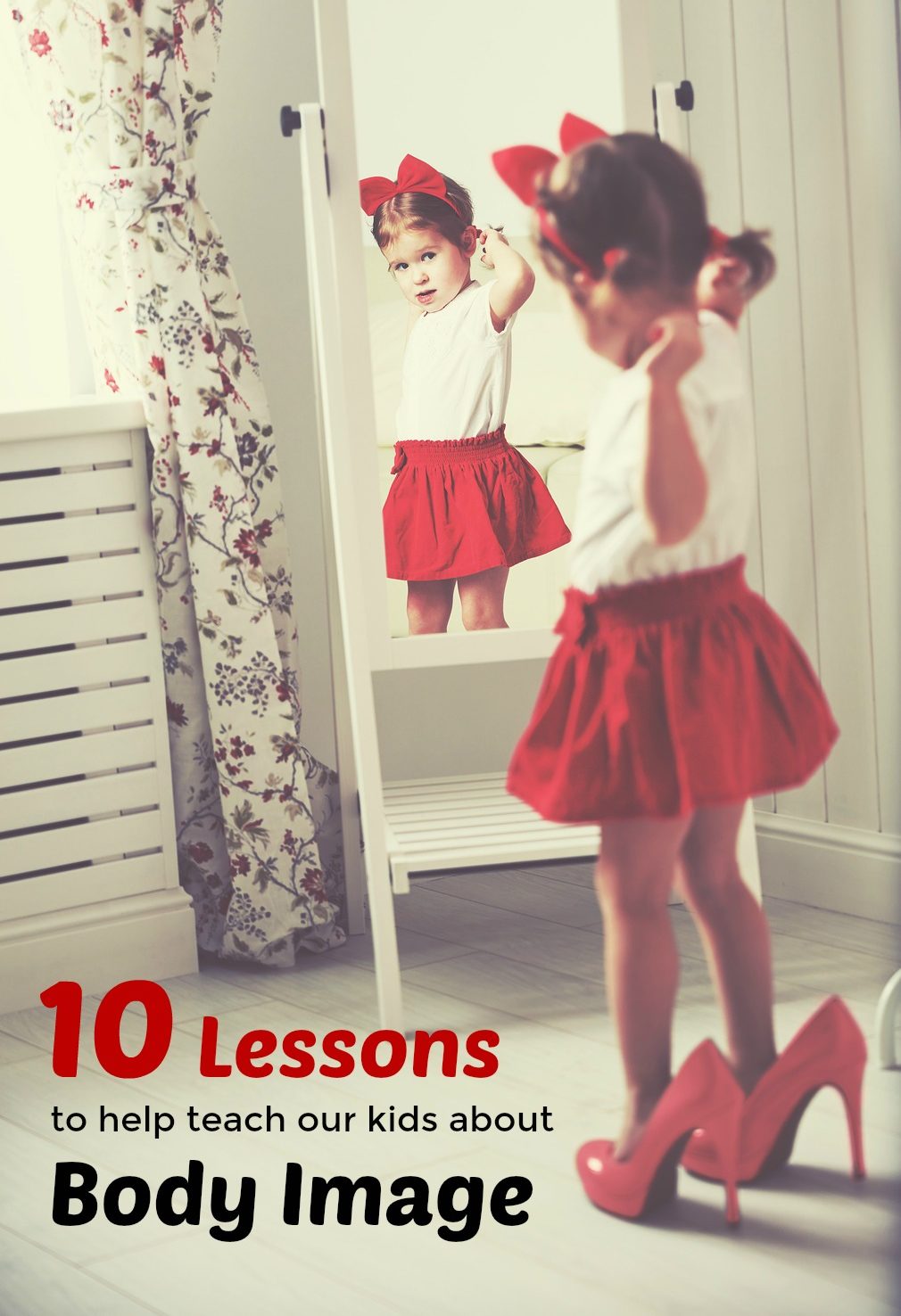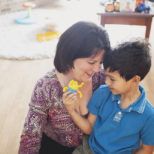“Conversations with your Kids” is a series in partnership with Responsibility.org, an organization that encourages parents to establish open lines of communication with their children, particularly around the issues of peer pressure and underage drinking. Each post will explore a specific topic with expert tips from Dr. Deborah Gilboa (Dr. G) on how to address these topics in an age appropriate way.
Mazzy and Harlow are six and three, almost seven and four. Some of the biggest issues we’ve addressed so far are table manners, gratitude and the importance of toothbrushing. But as they get older, I know I have to be prepared to talk about more serious topics. Like body image.
I’m not someone who has ever been overly confident about the way I look, particularly when it comes to my shape and size, but low self-esteem is obviously not something I want to pass on to my children. I’ve always been very conscious about not appearing self-conscious in front of my daughters, but they see me put on make-up every day and keep pretty covered up at the beach, and I know it’s only a matter of time before they start to see and hear things that might make them wonder about the importance of their looks too.
What message is the right message to send?
Dr. G’s Tips on How to Talk about Body Image with Our Kids
1. Take a moment to think about your own body image. Our own beliefs about our bodies inform what we teach our children more than anything else. Ask yourself good questions about what you love and what you don’t love about living in your own skin. Now think about why. We don’t have to pass on our own worries, but to avoid that, we have to know what those worries are.
2. Self-evaluate your self-talk. Do you say negative things about your body? Lots of adults (not just women anymore) disparage their own shape or beauty in conversation. Find things to love about yourself and that will help your kids to do the same.
3. Promote “being fit” without talking about “fat.” Kids do need to learn how to care for their bodies, and a big part of that means learning to be active and maintain a healthy weight. However, there are a lot of risks to focusing on the number on a scale. Instead of talking to kids about their weight, talk about how fit they are. Healthy choices plus being active equals a fit body.
4. Name those healthy choices. Many parents want to teach kids to eat better but worry about negatively impacting their child’s self-esteem. Talk about why water is the best drink. Discuss portion size, not body size. Do not connect their food to how they look. Connect food choices to being healthy.
5. Reinforce the fact that everyone has to move. Concentrate on what bodies are for, not how they appear. Can this body run or play or climb or lift or dance? Great! Muscles grow by using them, so keep doing that!
6. Be a mentor, not a mirror. Children absorb our values. That means that we have to train ourselves to ignore their looks, and focus on whatever we want them to value most about themselves. You can teach your child good grooming habits by talking about being clean or tidy, and it’s OK to have an opinion about what looks better if they ask you. In general, though, guiding kids by reflecting back to them the character traits we most admire will protect them from a lot of insecurity.
7. Teach kids to be critics… of the media. If your child watches commercials or looks through magazines, it’s past time to talk about what they are seeing. Try these developmentally targeted discussions:
Ages 3-6: “I notice you and your friend fight over who gets to play with this doll the most, how come?” If your child talks about its “looks” this is a great place to talk about beauty and who decides what it means.
Ages 7-10: “Whoa! Check out that model. Did you know that picture is fake?” Show your child one of many online videos about how much is a flat-out visual lie. Then ask your child to look for the changes in future pictures.
Ages 11-14: “Did you know that a lot of Insta photos are fake, too?” Not only advertising, a lot of folks are photoshopping their “candid” pictures on social media. And it’s not just celebrities. Talk about how to know if you can believe what you see, and the pressure to do that with your own pictures.
Ages 15-18: “Do you fall for the ads?” Use your teen’s greater maturity and natural skepticism about the world to her advantage. Ask her about the products she wants or buys, and how the advertiser tries to link that product to happiness or success.
8. Teach modesty without blame. Many parents want to encourage their children and teens to dress modestly. A problem can arise, though, when we warn kids that showing skin can “cause” bad behaviors in others. That teaches children that they bear some responsibility if someone speaks about or touches them inappropriately, and that is not true. To avoid that, talk to kids about choosing what other people notice first, and most, about them—like their friendly smile, positive attitude or kind heart. Give your kids the chance to shine in someone else’s mind by deemphasizing the visual and focusing on the positive aspects of their personality.
9. Show respect by listening. It’s a real struggle to listen to negativity about our kids – especially when it is that child saying the negative stuff about themselves. To truly help kids feel great about themselves, though, we have to listen and show empathy rather than arguing. Try a simple response, like “I hear that you don’t like this about yourself. I’m sorry you feel that way. May I tell you why I disagree with you?” This models respect for your child and their emotions while opening to the possibility that there’s another way of looking at things.
10. Talk about love. Ask your child to think about what she loves most about her friends. It’s unlikely to be their looks. The simple exercise of talking about what a child most admires in others, and why he or she wants to be around them is the greatest reminder they can get about what really matters.
If anyone has any more questions about body image that were not addressed here, please ask them in the comments. Dr. G will try to answer as many as she can!
To find out more about Responsibility.Org, click here.


























So many great tips! I love seeing this series again!
Thank you so much Bailey!
Love these tips! Thanks for sharing them.
Jessica, thanks for your feedback!
A thought about modesty… although this article’s approach is better than most, having a child focus on what they want noticed first and most will translate to making sure something else is noticed last and least. Modesty, in my opinion, is a dangerous concept all around that labels parts of your body as being bad. I think a better concept is that of appropriateness. Is swimwear appropriate to wear to school? Is a formal dress appropriate for hiking? Are denim shorts appropriate for a fancy dinner? Anytime we prioritize showing parts or try to hide parts of our body it brings about shame that is associated with those parts.
I so much agree! What IS modesty, anyway? I have heard an excellent mother talk about our personal ‘brand’, and if our clothing choices fit with our ‘brand’. If a teenager likes the way she looks in a bikini, why shouldn’t she wear it? If it makes her feel good to wear a low cut top, if she is proud of her body, why should we stop her. I prefer age and context appropriate- anything else leads very easily to slut shaming and victim blaming.
I love the idea of focusing on what is the right outfit for the right moment, Becci. And Josie, I agree that feeling comfortable and happy with your body is something to be celebrated!
But I recognize that some people have values that have a high regard for keeping some skin private. So for those folks, this can be a way to discuss it without (I hope!) bringing shame into the mix at all.
I absolutely love this post. Great tips for teaching children about modesty. xo ~ Megan The Fashionista Momma
Thank you, Megan! I just found your webiste and FB page and I love (and liked) it.
I’ve been wondering lately how to deal with my mom’s negative body self talk. She’s always talking about the pounds she needs to lose, or about how a family picture is nice except her “big fat belly.” My child isn’t old enough to really get it, but someday he will be. I feel like I’m much more well-adjusted than my mom in this area, but I don’t know what to do other than bluntly saying “You need to fix this for your grandchildren.”
Emily, wouldn’t it be great if you could say that and your mom could really hear it without being hurt? That’s not too likely, though.
A different approach might be to say, “I love you so much, it’s hard for me to hear you talking about why you’re not worthy to be in our pictures. Having you – exactly how you are – in the picture makes it more beautiful to me.” Another possibility is to say, “I need your help to teach my kids what really matters. I don’t want him to think that how someone looks is what’s important.”
I hope one of these might be useful in your conversations. If neither work, you will be able to talk to your children about this when your mom isn’t around and talk about the difference in your values.
Aslayin, I understand your stress! But don’t fear, it’s great that you heard her using this word and can ask her what it means to her. That will help you understand what she means by it and what she is taking in. Don’t be afraid of knowledge, she can handle the idea that a few people realize that their insides and outsides don’t match. This won’t hurt her at all and will give her the foundation to understand the world as she grows.
Ilana, this is not exactly related to this post, but I wanted to share this with you. It’s kind of expensive, but it could be a really cool opportunity for your girls! It’s a beautiful project, and the photographer is amazing.
https://www.furtherup-furtherin.com/
This is the kind of post that parents need to read and take notes from. Love your advice here, and definitely sharing this with friends. Thanks!